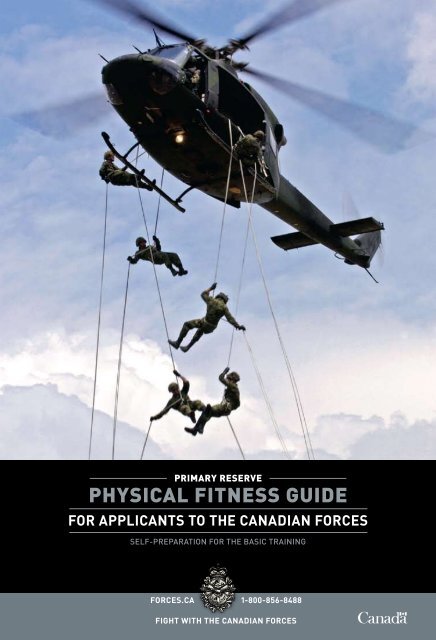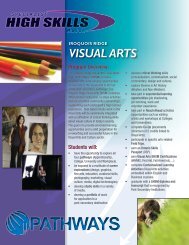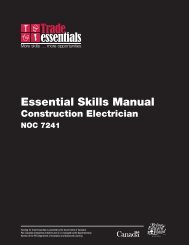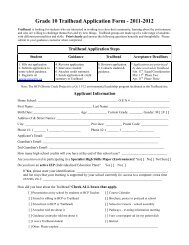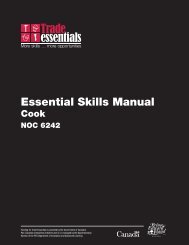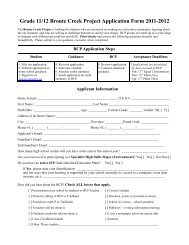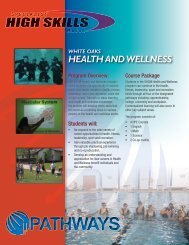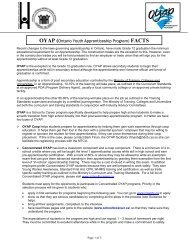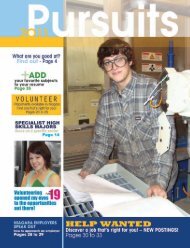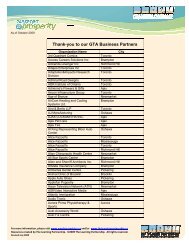Physical Fitness Guide - Canadian Forces Personnel Support Agency
Physical Fitness Guide - Canadian Forces Personnel Support Agency
Physical Fitness Guide - Canadian Forces Personnel Support Agency
You also want an ePaper? Increase the reach of your titles
YUMPU automatically turns print PDFs into web optimized ePapers that Google loves.
PRIMARY RESERVE<br />
<strong>Physical</strong> <strong>Fitness</strong> <strong>Guide</strong><br />
for Applicants to the <strong>Canadian</strong> <strong>Forces</strong><br />
SELF-PREPARATION FOR THE Basic training<br />
FORCES.CA 1-800-856-8488<br />
FIGHT WITH THE CANADIAN FORCES
Voices of Experience<br />
“My advice Be in the best possible shape you can be. Be ready for teamwork. Train now and quit smoking.” D.V.<br />
“Upper body strength is very important. You’ll discover you have muscles you never knew you had.” K.D.A.<br />
“Be prepared for a very physically and mentally exhausting experience. It’s well worth it though!” K.S.<br />
“The target goals are extremely high. Don’t wait until the last couple of days before you enroll to start working out.” S.M.<br />
Acknowledgements<br />
The following individuals were instrumental in the<br />
development of this guide:<br />
Wayne Lee, Ph.D. Directorate of Human Performance and<br />
Health Promotion, CFPSA<br />
Ben Ouellette, BPE, PFLC. Research & Development<br />
Coordinator, CFPSA<br />
Nicole Thomas, BPE, PFLC. CF Applicants <strong>Physical</strong> <strong>Fitness</strong><br />
Programs Coordinator, CFPSA<br />
Francois Lagarde, M.A. Social Marketing and <strong>Fitness</strong><br />
Consultant<br />
Gordon W. Stewart, M.Sc. Health and <strong>Fitness</strong> Consultant<br />
CFRG Multimedia Services<br />
Instructors of <strong>Canadian</strong> <strong>Forces</strong> Leadership and Recruit<br />
School (CFLRS)
Pre-Test Information & Instructions<br />
for Applicants to the <strong>Canadian</strong> <strong>Forces</strong> Primary Reserve<br />
To enroll in the <strong>Canadian</strong> <strong>Forces</strong> Primary Reserve, you are required to pass a physical<br />
fitness test as a part of the application process. This test is called the Primary Reserve<br />
Applicant <strong>Fitness</strong> Test. This test consists of the following:<br />
1. Push-ups 3. Hand grip<br />
2. Sit-ups 4. Aerobic fitness<br />
Pre-screening<br />
You will complete a health appraisal questionnaire and a pre-test vital signs check<br />
consisting of resting blood pressure and resting heart rate measurements by your tester.<br />
Dress requirement<br />
You should dress in running shoes, shorts, and a T-shirt or sweat shirt, with female<br />
applicants wearing a sports bra or a top part of a two-piece swim suit underneath.<br />
Proof of identification<br />
Bring photo ID, such as: current driver’s license, photo health card, military ID, photo<br />
student cards etc.<br />
Pre-test instructions<br />
To ensure an accurate test, please adhere to the following instructions:<br />
• <strong>Physical</strong> Exercise: No strenuous physical activity minimum six hours (6 hrs) before<br />
the test.<br />
• Food and Beverages: Do not eat for at least two hours (2 hrs) before your test. Refrain<br />
from consuming alcohol for at least six hours (6 hrs) before your test. Refrain from<br />
drinking caffeine beverages for at least two hours (2 hrs) before your test (tea, pop,<br />
coffee, etc.). Refrain from smoking for at least two hours (2 hrs) before your test.<br />
Note: The results of your test may be negatively affected if the conditions concerning<br />
dress, food, smoking, beverages and exercise are not followed. If you clearly ignored<br />
these instructions, the evaluator may cancel your test.<br />
Post-test<br />
You will remain in the test area until your post-exercise heart rate has decreased to<br />
less than 100 BPM.<br />
To maximize your chance for<br />
success follow these steps:<br />
1. read this guide from cover to cover;<br />
2. conduct a “self-assessment of your<br />
physical fitness”;<br />
3. conduct personal training and preparations<br />
for the test as required;<br />
4. conduct the Primary Reserve<br />
Applicant <strong>Fitness</strong> Test.<br />
The booklet contains:<br />
- a brief description of the demands<br />
of Basic Training;<br />
- tips and advice to help you get ready;<br />
- an explanation of the test;<br />
- specific steps that should be taken<br />
to ensure you are physically fit.<br />
Primary RESERVE // <strong>Physical</strong> fitness guide for applicants to the canaDian forces // SELF-PREPARATION FOR THE Basic training_1
The Demands of Basic Training<br />
Basic Training will teach you a new way of life. It may prove to be the most demanding<br />
experience you have ever had. It will require hard work and perseverance, so you will<br />
find it easier if you are prepared. Here are some of the things you can look forward to<br />
during Basic Training.<br />
• agility • athletics • chin-up • competition • dynamism • effort • endurance • energy •<br />
• exercise • fitness • flexibility • gymnastics • health • jump • limberness • movement<br />
• perseverance • potential • push-up • race • verve<br />
Daily Routine<br />
Your days will start at about 5:00 a.m.<br />
and will not be over until 11:00 p.m. Each<br />
training day will consist of physical training,<br />
marching, classes and practical sessions on<br />
a variety of military subjects. Evenings will<br />
be spent maintaining personal equipment<br />
and living quarters, and preparing for the<br />
next day’s classes.<br />
Field Exercises<br />
Field exercises focus on weapons firing,<br />
map and compass use, confidence (obstacle)<br />
course training, and forced marches of<br />
various lengths. You may also set up your<br />
own accommodations and do your own<br />
cooking. These exercises allow you to put<br />
into practice the theory you have learned<br />
up to that point in your training.<br />
Obstacle Course<br />
Obstacle course training involves<br />
performing physical tasks like scaling<br />
2 m and 4 m walls, climbing a 4 m netting<br />
apparatus, and traversing a 4 m ditch<br />
while hanging from a set of monkey bars.<br />
Good upper body strength and power<br />
are necessary to successfully complete<br />
the obstacle course. (This is one reason<br />
push-ups; chin-ups and other resistance<br />
exercises are emphasised in your<br />
pre-enrolment training program).<br />
Swimming<br />
If you attend Full-Time Basic Training, you<br />
must meet the military swim standard.<br />
This test involves jumping into a pool wearing<br />
a life jacket, and then swimming 50 m. You<br />
must also somersault into the water without<br />
a life jacket, tread water for two minutes,<br />
then swim 20 m.<br />
<strong>Physical</strong> Training<br />
Regular physical training sessions will prepare<br />
you for field exercises, forced marches, and<br />
help you meet the <strong>Canadian</strong> <strong>Forces</strong> Minimum<br />
<strong>Physical</strong> <strong>Fitness</strong> Standard.<br />
Training will include:<br />
• skill and strength development to help<br />
you complete the obstacle course;<br />
• running progressively longer distances<br />
to improve your fitness level;<br />
• conducting forced marches in combat<br />
clothing and equipment.<br />
Success at all times during Basic Training<br />
will depend on making a team effort and on<br />
the contribution of every member. If you are<br />
constantly tired during training because you<br />
are out of shape, you will not learn much,<br />
you will not do well on the field exercises,<br />
and you will not be a strong team member.<br />
So when you come to Basic Training, it is<br />
important for you to be as fit as you can.<br />
Getting Ready<br />
You should begin your preparation NOW to achieve as high a level of physical fitness as<br />
you can before Basic Training. Don’t put it off. The longer you wait, the more difficult it<br />
will be to meet the physical fitness demands of Basic Training.<br />
2<br />
2
activity • agility • athletics • chin-up • competition • dynamism • effort • endurance • energy • equilibrium • exercise • fitness • flexibility • gymnastics • health • jump • limberness • movement • perseverance • potential • push-up • race • resistance • ruggedness • sit-up • s<br />
• sport • strength • training • verve • vitality • walk • weightlifting • well-being • activity • agility • athletics • chin-up • competition • dynamism • effort • endurance • energy • equilibrium • exercise • fitness • flexibility • gymnastics • health • jump • limberness • movement •<br />
severance • potential • push-up • race • resistance • ruggedness • sit-up • speed • sport • strength • training • verve • vitality • walk • weightlifting • well-being • activity • agility • athletics • chin-up • competition • dynamism • effort • endurance • energy • equilibrium • exe<br />
• fitness • flexibility • gymnastics • health • jump • limberness • movement • perseverance • potential • push-up • race • resistance • ruggedness • sit-up • speed • sport • strength • training • verve • vitality • walk • weightlifting • well-being<br />
To Start off Right<br />
Assess Your Readiness<br />
Before you begin, complete the <strong>Physical</strong> Activity Readiness Questionnaire on page 4. Read it carefully and answer<br />
the questions. Then follow the Yes or No advice on page 5, whichever applies to you.<br />
Basic Training will require you to do a lot of marching and running, so you should talk to your doctor if you have any<br />
back, knee, ankle or foot problems that could be aggravated by this activity.<br />
Also if you think you may be pregnant, you are pregnant, or you become pregnant, speak to your doctor about your<br />
plans to join the CF and about your ability to do the activities required during Basic Training.<br />
Check Your Weight<br />
If you are carrying excess (fat) weight, you will have more difficulty meeting the fitness objectives and completing<br />
the various tasks in Basic Training. This is especially true if your training is in the summer – your extra weight could<br />
contribute to heat stress.<br />
Use the Body Mass Index information on page 5 to determine if excessive weight might be a problem for you.<br />
If it is, you should see your doctor or a public health nutritionist for advice. Weight loss is best achieved through a<br />
change in diet and regular physical activity, aiming for about half-a-kilogram loss per week.<br />
Watch Your Diet<br />
A nutritious diet will give you the fuel you need for regular physical activity. Junk food won’t do it! Your best bet is to<br />
follow the suggestions in Canada’s Food <strong>Guide</strong> to Healthy Eating. You can get a copy of the guide from the Recruiting<br />
Centre or from this web site: www.hc-sc.gc.ca.<br />
Primary RESERVE // <strong>Physical</strong> fitness guide for applicants to the canaDian forces // SELF-PREPARATION FOR THE Basic training_3
PAR-Q & You<br />
<strong>Physical</strong> Activity Readiness Questionnaire<br />
Regular physical activity is fun and healthy, and increasingly more people are starting to become more active<br />
every day. Being more active is very safe for most people. However, some people should check with their doctor<br />
before they start becoming much more physically active.<br />
If you are planning to become much more physically active than you are now, start by answering the seven<br />
questions below. If you are between the ages of 15 and 69*, the PAR-Q will tell you if you should check with<br />
your doctor before you start. If you are over 69 years of age, and you are not used to being very active, check<br />
with your doctor.<br />
Common sense is your best guide when you answer these questions. Please read the questions carefully and<br />
answer each one honestly: check YES or NO.<br />
• agility • athletics • chin-up • competition • dynamism • effort • endurance • energy • equilibrium • exercise • fitness • flexibility • gymnastics • health • jump • limberness • movement • perseverance • potential • push-up • race • resistance • ruggedness • sit-up • speed • sport • strength • training<br />
• vitality • walk • weightlifting • well-being • activity • agility • athletics • chin-up • competition • dynamism • effort • endurance • energy • equilibrium • exercise • fitness • flexibility • gymnastics • health • jump • limberness • movement • perseverance • potential • push-up • race • resistance •<br />
ness • sit-up • speed • sport • strength • training • verve • vitality • walk • weightlifting • well-being • activity • agility • athletics • chin-up • competition • dynamism • effort • endurance • energy • equilibrium • exercise • fitness • flexibility • gymnastics • health • jump<br />
Yes or No<br />
1. Has your doctor ever said that you have a heart condition and that you should only do physical<br />
activity recommended by your doctor<br />
2. Do you feel pain in your chest when you do physical activity<br />
3. In the past month, have you had chest pain when you were not doing physical activity<br />
4. Do you lose your balance because of dizziness or do you ever lose consciousness<br />
5. Do you have a bone or joint problem that could be made worse by a change in your<br />
physical activity<br />
6. Is your doctor currently prescribing drugs (for example, water pills) for your blood pressure<br />
or heart condition<br />
7. Do you know of any other reason why you should not do physical activity<br />
* The CF recruits applicants from the 17 to 55-age pool.<br />
4
WEIGHT IN POUNDS<br />
90 100 110 120 130 140 150 160 170 180 190 200 210 220 230 240<br />
HEIGHT IN CENTIMETERS<br />
150 155 160 165 170 175 180 185 190 195<br />
4’ 4’ 5’ 5’ 5’ 5’ 5’ 5’ 5’ 5’ 5’ 5’ 5’ 5’ 6’ 6’ 6’ 6’ 6’ 6’ 6’<br />
10” 11” 1” 2” 3” 4” 5” 6” 7” 8” 9” 10” 11” 1” 2” 3” 4” 5” 6”<br />
HEIGHT IN FEET AND INCHES<br />
If you answered…<br />
30<br />
27<br />
25<br />
20<br />
18<br />
106<br />
42 46 50 54 58 62 66 70 74 78 82 86 90 94 98 102<br />
WEIGHT IN KILOGRAMS<br />
Body Mass Index<br />
Body Mass Index considers your weight in<br />
relation to your height to determine if yours<br />
is a healthy weight or if you may be overly fat<br />
or too lean. This is a simple measurement<br />
and should be considered an estimate.<br />
To determine your weight status:<br />
• select your height – in feet and inches<br />
(across the bottom of chart) or in<br />
centimetres (across the top);<br />
• follow its vertical (up & down) line until it<br />
crosses the horizontal line of your body<br />
weight in pounds (on the left side of the<br />
chart) or in kilograms (on the right side); and<br />
• establish in which Weight Zone you are.<br />
If you score in the Caution zone, you may<br />
be carrying too much fat. If you score in<br />
the top dark/solid (Overfat) zone or in the<br />
bottom (Too Lean) zone, your weight may<br />
be associated with increased health risks.<br />
Remember that this is just an estimate – the<br />
procedure can misclassify some people. The<br />
chart can’t tell the difference between muscle<br />
and fat. For example, someone who is quite<br />
muscular might score in the top (dark) zone.<br />
But they aren’t overly fat and (muscle) weight<br />
doesn’t put them at increased risk of health<br />
problems like excess (fat) weight does.<br />
If you have any concerns about the accuracy of<br />
your score, talk to your doctor, to a registered<br />
dietitian or fitness specialist. You should also talk<br />
to your doctor if you scored in the Overfat or Too<br />
Lean zone to determine if there are any concerns<br />
about your safe participation in Basic Training.<br />
> 27 Increased risk of health problems due to excess weight<br />
20 - 27 Acceptable weight for most people<br />
25 - 27 Precautionary area<br />
20 - 25 Healthy weight for most people<br />
< 20 Increased risk of health problems due to underweight<br />
YES to one or more questions<br />
Talk with your doctor by phone or in person<br />
BEFORE you start becoming much more<br />
physically active or BEFORE you have a fitness<br />
appraisal. Tell your doctor about the PAR-Q<br />
and which questions you answered YES.<br />
• You may be able to do any activity you want<br />
as long as you start slowly and build up<br />
gradually. Or, you may need to restrict<br />
your activities to those that are safe for<br />
you. Talk with your doctor about the kinds<br />
of activities you wish to participate in and<br />
follow his/her advice.<br />
• Find out which community programs are<br />
safe and helpful for you.<br />
Note: <strong>Canadian</strong> Society for Exercise Physiology - (Informed use of<br />
the PAR-Q) The <strong>Canadian</strong> Society for Exercise Physiology, Health<br />
Canada and their agents assume no liability for persons who<br />
undertake physical activity, and if in doubt after completing<br />
this questionnaire, consult your doctor prior to physical activity.<br />
NO to all questions<br />
If you answered NO honestly to all PAR-Q<br />
questions, you can be reasonably sure that<br />
you can:<br />
• Start becoming much more physically<br />
active, begin slowly and build up gradually.<br />
This is the safest and easiest way to go; and<br />
• Take part in a fitness appraisal, this is an<br />
excellent way to determine your basic fitness<br />
so that you can plan the best way for you to<br />
live actively.<br />
Delay becoming much more active:<br />
• If you are not feeling well because of a<br />
temporary illness such as a cold or a fever,<br />
wait until you feel better; or<br />
• If you are or may be pregnant, talk to<br />
your doctor before you start becoming<br />
more active.<br />
Primary RESERVE // <strong>Physical</strong> fitness guide for applicants to the canaDian forces // SELF-PREPARATION FOR THE Basic training_5
Training Tips<br />
A good training program is effective, safe and enjoyable! Be sure to:<br />
• wear comfortable clothing that doesn’t restrict your movement and running shoes that<br />
provide good support and traction;<br />
• start at a level that’s right for you now and progress gradually from there;<br />
• take rest days when you need them so you don’t overdo it; and<br />
• run with a natural and comfortable stride length. Use a soft heel or flat-foot landing, rock<br />
forward, and gently push off your toes. Maintain an erect but relaxed posture, and move<br />
your arms forward and back (not sideways across your chest).<br />
Sample Training Session<br />
When starting a fitness program you should follow the FITT (frequency, intensity, time,<br />
and type) principle. This will ensure that you are getting the necessary training and recovery<br />
time for optimal gain.<br />
WARM-UP ( 5 – 10 min.)<br />
Typically a warm-up is used to increase blood flow to the muscles and prepare you for the<br />
activity that you have chosen to do as a workout. Light walking, biking, or a slow jog can<br />
be done to achieve these results. This should be followed by some light static stretching,<br />
stretching the muscles that you will be using in your training session.<br />
AEROBIC FITNESS/MUSCULAR STRENGTH SESSION ( 20 – 60 min.)<br />
When starting your session, take into consideration the frequency, intensity, type of activity<br />
and your goals. A rule of thumb is that you should ease into your activity and gradually<br />
increase the intensity. For example the first set of exercises in a weight program is a<br />
warm-up set despite the fact that you have done a structured warm-up.<br />
COOL-DOWN ( 5 – 10 min.)<br />
Your cool-down can be similar to your warm-up. Walking, biking or a slow jog will bring<br />
your heart rate down gradually to allow your body to repair itself and help relieve muscle<br />
soreness. A helpful hint for your stretching exercises is to progress methodically from head<br />
to toe so that no major joints or muscles are forgotten.<br />
ty • agility • athletics • chin-up • competition • dynamism • effort • endurance • energy<br />
brium • exercise • fitness • flexibility • gymnastics • health • limberness • movement •<br />
verance • potential • push-up • race • resistance • ruggedness • sit-up • speed • sport<br />
• strength • training • verve • vitality • walk • wewell-being • activity<br />
Warm-up and cool-down should be a regular part of your workout. Duration of these should<br />
be 5 – 10 min. This time is not counted as part of your 20 – 60 min. workout time. Stretching<br />
can also be included in your cool-down.<br />
Aerobic <strong>Fitness</strong> Session<br />
Following <strong>Canadian</strong> Society of Exercise Physiology guidelines:<br />
Frequency: 3 – 5 times a week<br />
• At the start of your program, exercising 3 times a week on non-consecutive days is best. After a few weeks you<br />
can increase your frequency to 4 – 5 times a week.<br />
Intensity: 65 – 90% of your max heart rate *<br />
• 220 - age X (intensity%)<br />
Ex.: 30 years old working at 70% of max HR<br />
220 - 30 X (70%) = 190 X (70%) = 133 BPM<br />
Time: 20 – 60 Minutes<br />
• The first few weeks of your workout, the duration of your sessions should be closer to 20 minutes. Once you are<br />
comfortable with that time you can gradually increase your time by 2 – 3 min/week. The frequency and duration<br />
should not be increased in the same week, increase them one at a time.<br />
Type: Any activity that raises your heart rate for the duration of your workout is a good activity. You should however<br />
work towards running, as this is a major component of Basic Training. Sample activities: walking, running, biking,<br />
rope skipping, stair climber, aerobic classes, swimming, etc..<br />
* Estimated max heart rate = (220 - age). If these calculations are confusing consult a trained fitness specialist.<br />
6
PRIMARY<br />
RESERVE //<br />
Muscular Strength Session<br />
Following <strong>Canadian</strong> Society of Exercise Physiology guidelines:<br />
Frequency: 2 – 3 times per week. Major muscle groups.<br />
Intensity: The appropriate weight is that which you can lift the required<br />
number of times and not more. *<br />
<strong>Physical</strong> fitness guide for applicants to the canaDian forces // Self-preparation for basic training >><br />
1 set<br />
8 – 12 reps<br />
8 – 10 exercises<br />
Time: 15 – 60 min. Progressive.<br />
Type: Resistance training (Free weights/machines) Include push-ups, sit-ups<br />
and chin-ups in your program, as these are components of Basic Training.<br />
* For more information consult a trained fitness specialist.<br />
Primary RESERVE // <strong>Physical</strong> fitness guide for applicants to the canaDian forces // SELF-PREPARATION FOR THE Basic training_7 VERSION 2
Primary Reserve<br />
Applicants<br />
<strong>Physical</strong> <strong>Fitness</strong> Test<br />
To ensure that you are ready for the demands of Basic<br />
Training, you will be asked to undergo a <strong>Physical</strong> <strong>Fitness</strong><br />
Evaluation as a part of the recruiting process. Successful<br />
completion of this Evaluation is a necessary step toward<br />
being accepted into the <strong>Canadian</strong> <strong>Forces</strong>.<br />
There are four test items in the Evaluation: a Step test to<br />
measure your aerobic fitness, push-up and sit-up tests<br />
to measure your muscular endurance, and a hand-grip<br />
(squeeze) test to measure your muscular strength.<br />
Performance Objectives<br />
The performance objectives to be met are shown below.<br />
Test item Men Women<br />
1. Push-Ups<br />
Under 35 years of age 19 9<br />
35 and older 14 7<br />
2. Sit-Ups<br />
Under 35 years of age 19 15<br />
35 and older 17 12<br />
3. Hand Grip (in kilograms)<br />
(Combination of your left and right hand scores)<br />
Under 35 years of age 75 50<br />
35 and older 73 48<br />
4. Aerobic <strong>Fitness</strong><br />
Acceptable rating for 2.4 km run will prepare you<br />
to meet the aerobic fitness standard.<br />
2.4 km run – <strong>Fitness</strong> categories (time in minutes)<br />
Men Age Acceptable Superior<br />
Under 30 years 11:56 – 10:13 < 10:13<br />
30 – 34 12:26 – 10:35 < 10:35<br />
35 – 39 12:56 – 10:58 < 10:58<br />
40 – 44 13:25 – 11:12 < 11:12<br />
45 – 49 13:56 – 11:27 < 11:27<br />
50 – 54 14:25 – 11:57 < 11:57<br />
55 & over 14:56 – 12:27 < 12:27<br />
Women Age Acceptable Superior<br />
Under 30 years 14:26 – 12:36 < 12:36<br />
30 – 34 14:55 – 12:57 < 12:57<br />
35 – 39 15:25 – 13:27 < 13:27<br />
40 – 44 15:55 – 13:57 < 13:57<br />
45 – 49 16:25 – 14:26 < 14:26<br />
50 – 54 16:54 – 14:56 < 14:56<br />
55 & over 17:24 – 15:27 < 15:27<br />
D2-235/2008<br />
978-0-662-06003-1<br />
5. Chin-ups Men Women<br />
Under 35 years of age 6 3<br />
35 and over 4 2<br />
8
<strong>Physical</strong> <strong>Fitness</strong><br />
Training Techniques<br />
1. Push-Ups<br />
Start position, Down position.<br />
Top view, Up position.<br />
2. Sit-Ups<br />
Start - Down position.<br />
Up position.<br />
9
3. Hand Grip<br />
4. Aerobic <strong>Fitness</strong><br />
5. Chin-Ups<br />
Self-Assessment<br />
of <strong>Physical</strong> <strong>Fitness</strong><br />
As you pursue your training you will want to assess your progress against the objectives<br />
in the Pre-Enrolment <strong>Physical</strong> <strong>Fitness</strong> Evaluation. You can assess yourself as often as you<br />
wish. The techniques used for push-ups and sit-ups during the Evaluation are explained<br />
here. Use these techniques during training and self-assessment. You may not have access<br />
to a hand-grip measuring device. However, performing chin-ups will help you prepare for<br />
this test.<br />
1. Push-Ups<br />
Lie flat on your stomach, legs together. Hands, pointing forward, and positioned comfortably<br />
under the shoulders. To establish an acceptable hand position, an observer standing over<br />
top of you should be able to see part of your hand but not all of your hand. If they can see all<br />
of the hands the base is too wide. Conversely, if the hands are in under the chest then the<br />
position is too narrow. Elbows are comfortably back along sides. Push up from the mat by<br />
straightening and locking the elbows and using the toes as the pivot point. The body must<br />
be kept in a straight line. When returning to the starting position, the back of the upper arms<br />
will be pa ra llel to the mat. Normally, neither the chin, stomach, thighs, nor knees are to touch<br />
the mat. Push-ups are to be performed continuously and without a time limit. Repetitions that<br />
do not conform to the push-up test technique should not be counted. Perform this motion<br />
in a continuous manner. Do as many repetitions as you can. Stop the test when the movement<br />
becomes forcibly strained.<br />
2. Sit-Ups<br />
Lie on your back, with your knees bent at a 90-degree angle and feet flat on the floor about<br />
30 cm apart. Have someone hold your ankles to ensure that your heels are in constant<br />
contact with the floor. Place your hands on the side of your head and they must be maintained<br />
in this position throughout the test. By keeping the lower back flat against the ground, begin<br />
the movement, curl up and touch the knees with your elbows (count “one”) and return to<br />
the starting position. Perform as many repetitions as possible within one minute. Ensure<br />
that your shoulder blades return to their initial position each time. You may pause whenever<br />
necessary. Stop the test when the movement becomes forcibly strained or when you start to<br />
lift your buttocks off the floor at the beginning of a repetition.<br />
3. Hand Grip<br />
Although you may not have access to a hand grip dynamometer, the protocol is as follows:<br />
Starting with your left hand, hold the dynamometer between the fingers and the palm at the<br />
base of the thumb. Hold the instrument away from the body, squeeze vigorously exerting<br />
maximum force. Apply the same protocol to your right hand and repeat a second time.<br />
Combination of your best score for both hands will be calculated.<br />
With arms straight.<br />
4. Aerobic <strong>Fitness</strong> 2.4 km Run<br />
During your Pre-Enrolment <strong>Physical</strong> <strong>Fitness</strong> Evaluation, a qualified instruc tor will conduct a<br />
step test to measure your aerobic fitness. For the Self-Assessment, however, you will have<br />
to do a 2.4 km run to gauge your level. Be sure to pursue a gradual running program over<br />
several weeks prior to the test. You should be able to run 5 km before you attempt the test.<br />
Complete the test on a regulation running track (six laps of a 400 m track) or over a measured<br />
course. (If necessary, you can measure out a course using the odometer on a car).<br />
Use the chart below to assess your results. Remember that achieving an acceptable rating<br />
will prepare you to meet the required objective on the Step Test Evaluation.<br />
5. Chin-Ups<br />
Note: Chin-ups are not part of your official Pre-Enrolment Evaluation. However, minimum<br />
objectives for chin-ups are included, because they are an important part of your Basic Training.<br />
Hang from a chinning bar with the palms of your hands facing you (thumbs to the outside)<br />
and your arms fully extended. Without swinging your legs, pull up by bending your elbows<br />
until your chin is just above the bar, then lower yourself slowly to the starting position.<br />
Exhale as you pull up, inhale on the way back down.<br />
Horizontal bar position.<br />
Perform this motion in a continuous manner, without resting between repetitions. Count<br />
one every time a chin-up is completed. Do not count any time swinging occurs.


